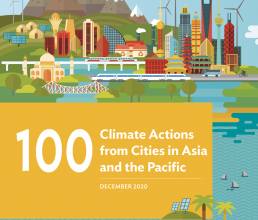First appeared in

Asian Development Bank
100 Climate Actions from Cities in Asia and the Pacific
Despite freezing winters, Mongolia’s capital has bountiful solar radiation, which the 15 megawatt (MW) solar plant just outside Ulaanbaatar is now harvesting.
Despite freezing winters, Mongolia’s capital has bountiful solar radiation, which the 15 megawatt (MW) solar plant just outside Ulaanbaatar is now harvesting.
Forty kilometers from Mongolia’s capital city on open grassland steppe, lies one of Mongolia’s largest solar power plants — a 15 MW array with over 15,000 photovoltaic panels. It provides an estimated 22.3 gigawatt hours (GWh) of electricity annually that is fed into the national grid, while lowering the country’s carbon emissions by 26,400 tons annually.
22.3
GWH OF ELECTRICITY PRODUCED ANNUALLY
GWH OF ELECTRICITY PRODUCED ANNUALLY
Ulaanbaatar is the coldest capital city in the world. Despite this, there is still much potential for solar energy. The city has an annual average of 2,800 hours of sunshine, which is more than Madrid. Ulaanbaatar also struggles with some of the world’s worst air pollution in the winter, although this is mostly due to burning coal for heat and from the transportation sector.
This is one of several projects aiming to develop Mongolia’s renewable energy portfolio and help to increase the share of renewable energy in the total installed power generation capacity to 20% by 2023 and 30% by 2030.
The $26.7 million project is financed through loans from ADB and the Leading Asia’s Private Infrastructure Fund (LEAP).

Local green jobs are created with the push for renewables in Mongolia (photo by ADB).
The Challenge
With Ulaanbaatar’s large population and heavy reliance on fossil fuels, it can help the government shift to clean energy sources and increase its share of renewable energy to a targeted 30% by 2030 by harnessing solar power generation.
Co-Benefits
Economic Installing new photovoltaic capacity leads to generation of local employment.
Health Reducing Mongolia’s reliance on coal for energy will improve air quality especially in densely populated cities like Ulaanbaatar.

